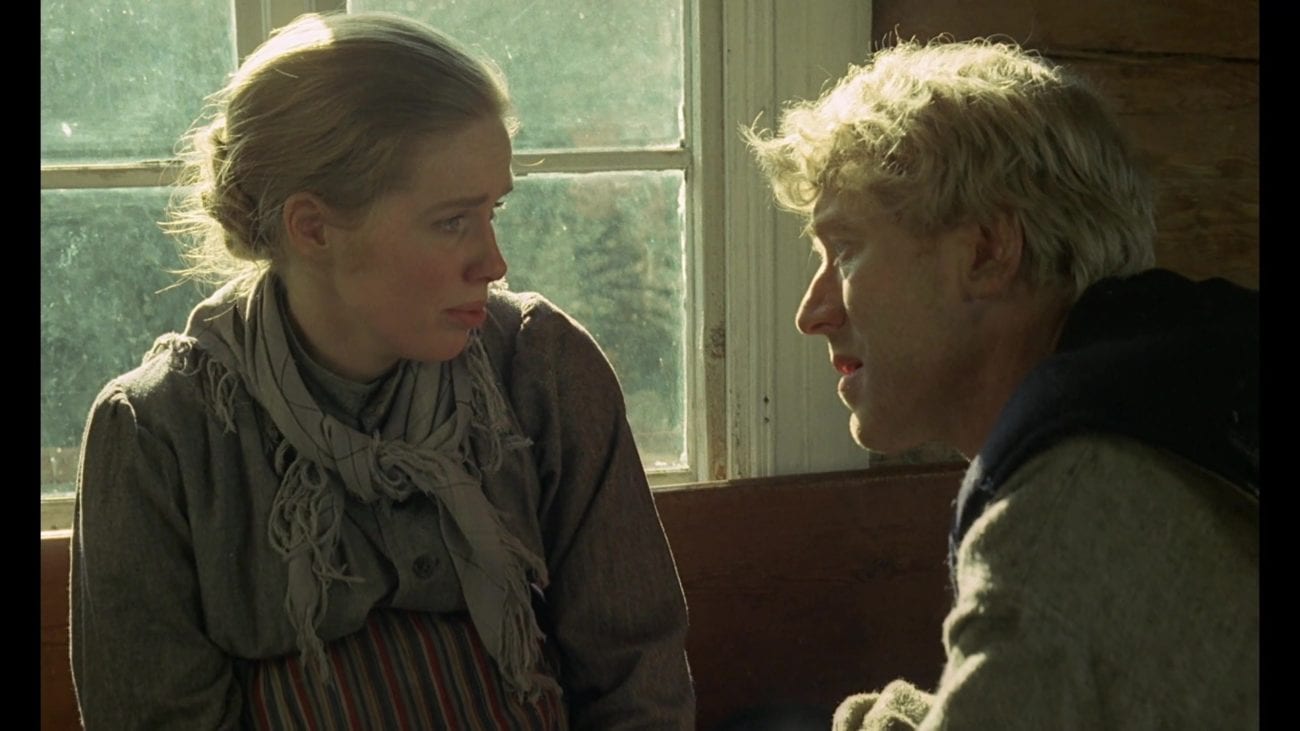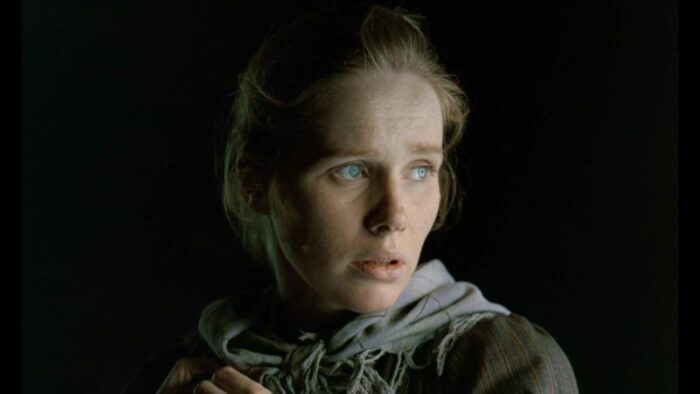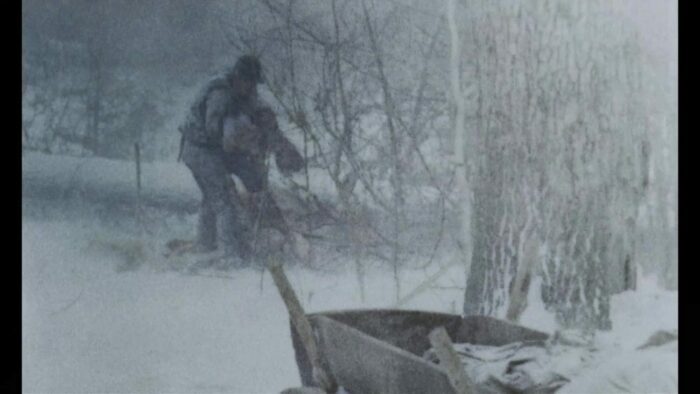After more than a year of pandemic-enforced lockdowns and a turn towards our smaller screens, longform narrative seems to have reached the apex of its popularity. Streaming services in particular embrace serialized drama told in smaller increments. But filmmakers have known for better than a century the power of a story told in episodes. Whether in the serial melodramas of the silent era or the stories of Apu Roy or Antoine Doinel told by Satyajit Ray and François Truffaut, longform is no stranger to cinema. Much like that other, better-known, and more-heralded immigrant saga of the 1970s The Godfather, Jan Troell’s films The Emigrants (Utvandrarna, 1971) and The New Land (Nybyggarna, 1972), produced contemporaneously and with the same cast featuring Max Von Sydow and Liv Ullmann, employ longform storytelling to its full potential in an epic saga of emigration to North America.

Nominated for the Academy Award for Best Foreign Language Film in 1971, The Emigrants had the rare honor of being nominated for four more Oscars, including Best Picture, the next year, upon its North American release in 1972. That same year its sequel The New Land was also nominated for Best Foreign Language Film. The two films together form a diptych, a pair of films that extend and inform each other to the extent that neither really is meant to stand alone. Each of them over three hours long with an intermission, they demonstrate the necessity of longform filmmaking. The slow rhythms of the first hour of The Emigrants give way to a faster pace as a small family and their friends across the world to The New Land. Now fifty years since its Swedish debut (its own venture to U.S. screens taking some 18 months), The Emigrants and The New Land together continue to inform and depict one of the many important pieces of the American immigrant experience—that of the struggle of hundreds of thousands of Swedish people to establish homesteads and lives in the Midwest.
The Emigrants opens with nondiegetic exposition articulating in the most straightforward way imaginable the film’s intent. “This is the story of a group of people who emigrated to America from their homes in Ljuder parish in the Swedish province of Småland.” That parish is characterized in a dispassionate ledger of its 1,925 inhabitants in 1844, from its 254 farmers and 39 artisans to “92 landless peasants, 11 enlisted soldiers, 274 farmhands, 127 paupers, 60 cripples, five halfwits, three idiots, three whores, and two thieves.” They are governed by those who possess the “virtue of their spiritual and temporal offices”: the dean; the sheriff; a landowner, lieutenant, and knight; and the churchwarden-storekeeper. Power and authority are a matter of rank and privilege.

Adapting the series of four Emigrants novels by Vilhelm Moberg, Troell emphasizes a caste system that maintains and enforces a strict social hierarchy, one that serves those at its top by relying on the subjugation of those below. Troell’s camera pans slowly over a dispassionate congregation hemmed in tight quarters, each Swede’s face etched in fatigue and discomfort. The Swedish landscapes are less than pastoral, quietly inventorying a farmland beset by infertile soil, unplowable fields, long droughts, and fiery lightning strikes: the opening hour charts the trudge and toil of broken plows and limbs in a quiet, stewing simmer.
More than six minutes pass before Troell so much as introduces his protagonists. On their farm at Korpamoen, hardworking eldest son Karl Oscar Nilsson (Max Von Sydow) inherits his father’s stubborn land and with it its mounting debts. He meets and marries Kristina Johansdotter (Liv Ullmann), whose naïve faith contrasts with Karl Oscar’s more earthbound struggle, and the two’s growing family becomes increasingly impossible to feed. Karl Oscar’s younger son Robert (Eddie Axberg), a bright daydreamer, is lent out as a farmhand to assuage their debt but is mercilessly beaten by his cruel new master, eliciting injury that will impact him for years. Others in Ljuder parish suffer the ignominy of religious persecution. Kristina’s uncle Danjel (Allan Edwall) is admonished and eventually sentenced for the crime of ministering in his home without ordainment. The prostitute he has taken in, Ulrika (Monica Zetterlund), knows first-hand the hypocrisy of the church and town leaders.

Separately and for different reasons, Karl Oscar, Robert, Danjel, and Ulrika conclude that the promise of emigration to North America must be worth the risk of ostracization from their homeland and the challenge of the long transatlantic passage. Their efforts, like those of the hundreds of thousands of Swedes who began to emigrate in the 1850s, were met with stern disapproval by their village elders, government, and church, who collectively feared the loss of culture, labor, and parishioners. But set sail they did to North America, where like Karl Oscar they were generally welcomed for their quick assimilation and reputed work ethic.
At the conclusion of their arduous journey by ship, train, and steamboat—and at the end of the first of the two films—the Nilssons and their group arrive near Taylors Falls, Minnesota, a three-day walk through thick forest. Trekking even further than the others, Karl Oscar there triumphantly claims his stake of the land he will stead. As the couple whose family’s journey centers the narrative of The Emigrants and The New Land, Von Sydow and Ullmann marvel. Von Sydow as Karl Oscar strides across his new land with vigor and purpose. His is an energy borne not of ideology but survival and determination. To him, emigration is the last, most logical, and eventually only option to feed his family in a time of scarcity. Von Sydow plays Karl Oscar as slow but not impossible to anger, resolute and determined, a man of few words but near-constant labor. The actor’s recent passing makes it an especially enjoyable experience to spend six hours with him again onscreen, and Von Sydow is lithe enough to appear convincing as both a young man and an old one.

Ullmann glows as his youthful and fertile bride whose love for homeland and devotion to faith are much stronger than her husband’s, a conflict that follows them across the ocean. She is skittish, even fearful, but with good reason, given the upheaval their emigration demands and the dangers she will face in North America. Kristina frets about her children’s loss of homeland and fights to keep its memory alive. Her character grows, ultimately accepting Ulrika as a friend and equal. Her labor is constant too, a fertility that will ultimately prove her demise. The couple’s losses—a child to illness, a bout with infestation, Kristina’s own bouts with illness, and her ongoing struggle as a pioneer woman in a new land—cement their relationship as giving and enduring.

By the time of The Emigrants and The New Land, these two veterans of the Swedish cinema had co-starred together four times, including as more tortured married couples in Ingmar Bergman’s Shame and Hour of the Wolf and as lovers in his The Passion of Anna. They inhabit their roles with the cozy worn-in domesticity of a couple familiar enough with each other to communicate with touches, glances, and gestures, navigating if not always negotiating their conflicts. Eddie Axberg as the younger brother Robert brings a wide-eyed naivete to the role; his work as sound editor is especially acute, given his character’s hearing loss, in The New Land, his disability registered with subjective and distorted ambient sound. (Axberg served double-duty as featured cast and sound editor; Troell, triple-duty, as director, cinematographer, and editor.)

The second of the two films charts the family’s establishment of a family farm near the Chisago Lakes area of Minnesota, beginning in 1850 and continuing over the four decades that follow. Unlike The Emigrants, The New Land—not, I suppose, unlike the settling of its new country—is more chaotic, told at a faster pace, covering 40 years with flashbacks, flashforwards, and a good deal more subjective perspective. One harsh winter blizzard results in Karl Oscar’s saving his young son Johan from the harsh cold by gutting an ox and storing him inside, inspiring similar scenes years later in The Empire Strikes Back and The Revenant. This and many scenes occur with long stretches of no dialogue. An especially provocative sequence using percussive instrumentation to condense Robert’s search for California gold into an expressivist montage of parched land, intense heat, contagious disease, and tragic loss. He and the others learn that the caste system they risked their own lives to escape is every bit as firmly established in the United States as it had been in Sweden.

Isabel Wilkerson argues in Caste: The Origins of Our Discontents that America’s founding employed an infrastructure that, though unspoken, served as the very foundation of its economic system. The strict and overt caste system that subjected the Nilssons to government and religious rule in Sweden operated every bit as thoroughly in the new land to which they emigrated. The New Land makes clear that while North America would open its doors to European emigrants in the latter half of the 19th century it would also maintain strict enforcement of caste rules. To watch these films a half-century after their release is to be reminded that this country, founded on the back of immigrant labor and the genocide of natives, has yet to fully reconcile its past with its present. The irony that the Nilssons left their homeland to escape a restrictive caste system only to become part of a new one—where by virtue of their skin color they could be free from indentured servitude—is pointed.
While Troell is especially sensitive to the plight of his Swedish emigrants, his characterization of Native Americans as foreign threats is several degrees less so. For the most part, the Dakota lurk silently in the forest, emerging only seeking food—that is, until the uprisings of 1862, which are shown to claim the lives of Danjel and his family in Meeker county. Troell depicts the subsequent hanging of 38 Native American prisoners in Mankato, the largest single-day mass execution in American history, lending some tragic counterbalance to their characterization. Granted, the plight of the Native American is neither the director’s nor his film’s focus. Other American films of the era like Soldier Blue and Little Big Man were just beginning to attempt to chart this era of conquest and settlement from perspectives other than that of white Europeans. But like its 1972 competition for Best Picture The Godfather, The Emigrants and The New Land, work best when seen as—just as its first moments declare—“the story of a group of people who emigrated to America.”

Among the other hundreds of thousands of Swedish emigrants to North America was one born in Ostra Torsas in Småland, some 30 kilometers west of Ljuder. John Fagerstrom left Sweden in 1867 for Dakota Territory, where he would homestead land in Marsh Township and raise a family of eight, including my maternal grandmother, on the North Dakota farmland where my siblings and I were raised three generations later. Several seasons of intense cold and poor harvests had led to famine in Sweden, and discontent over the lack of government relief contributed to skyrocketing emigration numbers around this time. My great-grandfather was part of a second wave of emigration from Sweden to the U.S. that the first emigrants like the fictional Karl Oscar and Kristina Nilsson made possible. By 1890—the year of Von Sydow’s character’s death—the U.S. census counted over 800,000 Swedish-Americans, most of them settled into the American Midwest from Chicago to Dakota Territory.
Troell’s The Emigrants and The New Land, taken together as a diptych, is as instructive as any work of cinema about the experience of leaving one land for another. Its naturalistic compositions and acting, elongated pace and vast scope, impeccable cast and tragic story make for viewing essential to understanding the American experience, based as it is on emigration itself. The Swedish emigrants of the mid-19th century may not look outwardly much like those leaving their homelands for the Southern border of the U.S. today, but their hopes and dreams—escaping religious persecution, strict caste systems, harsh living conditions, and looking for a safer and more prosperous life—cannot be all that different from those a century and a half later. The story was adapted for American television (with a young Kurt Russell) as The New Land in 1974 and is being remade as The Emigrants today in Sweden (by director Erik Poppe for Svensk Filmindustri, but regrettably now without the participation of Liv Ullmann, who withdrew reportedly due to the impact of the pandemic). And as Troell’s diptych turns 50 and the U.S. faces ongoing challenges with immigration, its topics and approach are every bit as relevant today as they were upon its release.
Jan Troell’s The Emigrants and The New Land are available on DVD and Blu-ray as a part of The Criterion Collection.



